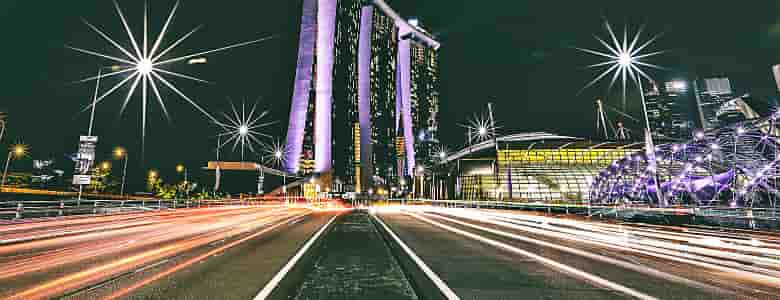Highway to Singapore's Smart Future

Governments across the globe are rolling out strategic plans to build smart cities that harness the power of the digital future. From intelligent street lighting to connected cars, smart cities are already inching their way to reality today and inadvertently putting a strain on data networks.
Governments recognize the emerging challenges of building a smart city. It isn’t just about providing adequate bandwidth to cater to constant connectivity across infrastructure and “things.”
IDC predicts that “by 2017, 75 percent of cities worldwide will fail to take full advantage of smart city data and digital assets due to a lack of process, project management, and change management skills,”.
It is therefore important for any city aspiring to improve the lives of their citizens to lay the core foundation on which the future digital-driven economy will run.
The Singapore Government has aggressively laid the pathway to transform into a Smart Nation.
It has invested millions to transform various sectors of the economy and build broad ecosystems of partners to explore and implement complex initiatives at the policy and infrastructure level.
The latest development is the formation of the Smart Nation and Digital Government Office (SNDGO) that will drive the Smart Nation initiative and the digital transformation efforts in the public service.
However, for the island state to truly reap the opportunities in the connected economy, it will need a robust communications network that is capable of delivering a personalized, connected experience to Singaporeans.
Communications network: Backbone of a Smart City
Smart cities are big complex projects for any nation to undertake.
Often, a key enabler is the “central nervous system” of the city in the form of a broadband network.
To achieve this, smart cities require common open platforms and an underlying ubiquitous ICT infrastructure, which includes high-speed internet access as well as wired and wireless networks. They also need an ICT application and service enablement suite, which includes smart media service enablers and citywide open access to sensors and actuators
Although the country is ahead of the game in defining itself as a digital economy, Singapore needs constant review of its communications network infrastructure to ensure it is integrated and interoperable.
For instance, for driverless cars to operate smoothly in Singapore, applications from vehicles must be able to seamlessly communicate with sensors on the roads, traffic monitoring systems and a host of other artificial intelligent systems such as parking and routing.
An intelligent communications network architecture is the only way to deliver this outcome.
Elements of communications network for Smart City
As the nation continues to make strategic investments for its future economy, ensuring its communications network has these important qualities will accelerate Singapore’s journey toward a smart economy.
Flexible and scalable network
It is hard to predict or envision the demands on the future network as digital transformation of the economy can have an exponential impact. To keep networks flexible and adaptable to changing socioeconomic objectives, Singapore can look at consumption-based infrastructure that will provide maximum flexibility alongside cyclical demands. Consumption-based infrastructure provides Singapore with the ability to adopt new technologies, while eliminating concerns of depreciating assets.
Applications – the future brains of smart cities
In an age where constant innovation and iterations of applications is a norm, today’s networks must be able to assimilate and integrate new applications quickly and without disruption. An application fluent network will simplify the rollout of new policies, regulations or services, thus ensuring citizens continue to enjoy a seamless, positive experience.
Interoperability
A successful smart nation depends on the smooth running of various systems in concert, feeding endless streams of information to an array of sensors and applications. The Land Transport Authority in Singapore, for example, can implement technology solutions to improve the safety of roads here.
Intelligent Transport Systems (ITS), as these systems are known, require reliable, secure and scalable networks to link cameras, sensors, signage, signalling and vehicles to remote data centers and operation centers.
These networks will be deployed in harsh environments and will pose their own unique challenges to operate, maintain and manage.
The communications network for the smart city must be able to orchestrate complex communications in this highly interconnected environment.
Security
Earlier in 2017, a breach in an internet-connected system belonging to the Ministry of Defence (MINDEF) resulted in the theft of personal data for 850 national servicemen and employees.
Although no classified military data was stolen in the breach, the incident serves a reminder that the open, interconnected nature of smart cities are easy targets for hacks, data breaches, information theft, and other malicious network attacks. A multi-layered approach against cyber threats is integral for smart cities to stay smart.
I will conclude by stating that Singapore is becoming a model for nations building smart cities the world over.
Its policy of investing ahead of demand to make markets more efficient and open new areas for economic development has worked well for the economy and has laid a strong foundation for its future.
However, what sets Singapore apart is its willingness to engage private partners and the global ecosystem of experts as well as its openness to continuously evolve and reinvent itself, as it creates a highway to a shared — and smart — future for its citizens.
This commentary was contributed by Mr Pierre Samson, Vice President APAC, Alcatel-Lucent Enterprise. The views expressed are solely the contributor’s own, and do not reflect any official position of GovTech.
https://www.tech.gov.sg/media/technews/highway-to-singapore-smart-future
